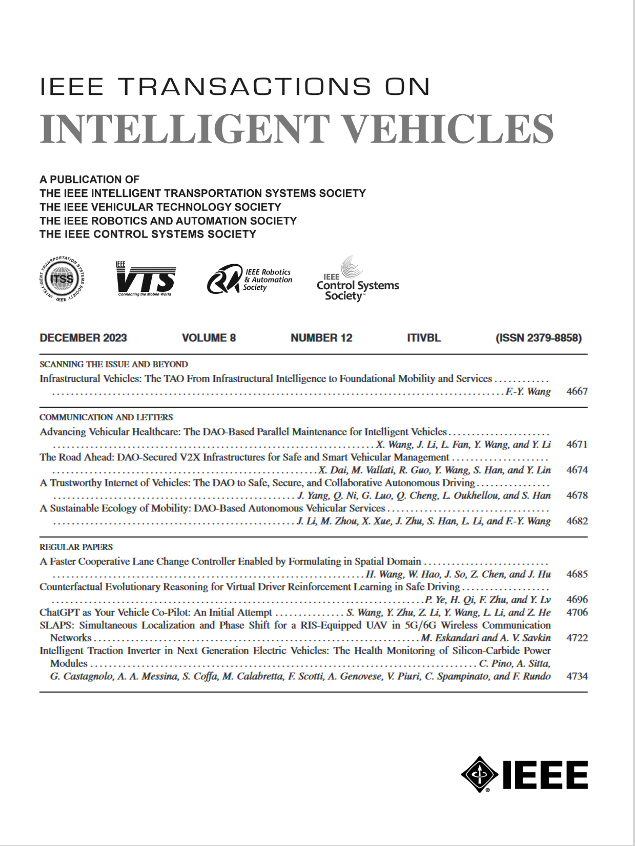基于运动的相机-激光雷达在线标定与3D相机地面
IF 14.3
1区 工程技术
Q1 COMPUTER SCIENCE, ARTIFICIAL INTELLIGENCE
引用次数: 0
摘要
提出了一种新型的相机-激光雷达在线无目标标定方法。随着自动驾驶汽车中异构传感器的安装越来越多,传感器校准的重要性也越来越大。自动传感器校准功能对安全自动驾驶至关重要,可以响应传感器的几何变化。本文介绍了传感器标定的背景知识,并参考了相关文献。学习深度估计和语义分割模型,使用开放和自定义数据集从相机中检测重要区域。本文介绍了基于运动标定的摄像机与激光雷达在线标定过程。基于运动的校准面临着缺乏滚转和俯仰变化的挑战,我们的方法通过语义分割和深度估计来估计相机三维地平面,同时检测3D激光雷达地平面,从而克服了这一挑战。然后利用相机和LiDAR地平面提取激光雷达到相机的滚转、俯仰和z值,并以这些值作为约束来解决和优化基于运动的校准问题。在城市道路和试验场c轨道上进行的自动驾驶汽车实验结果表明,本文提出的方法在数量和质量上都是对现有方法的改进。本文章由计算机程序翻译,如有差异,请以英文原文为准。
Motion-Based Camera-LiDAR Online Calibration With 3D Camera Ground
This paper addresses a novel camera-LiDAR online targetless calibration method. As the installation of heterogeneous sensors in autonomous vehicles is increasing, the importance of sensor calibration is also growing. An automatic sensor calibration function is essential for safe autonomous driving, responding to the sensor's geometric change. In this paper, background knowledge of sensor calibration is explained, and related papers are referenced. Depth estimation and semantic segmentation models are learned to detect significant regions from the camera using open and custom datasets. This paper describes the online calibration procedures based on motion-based calibration between the camera and LiDAR. Motion-based calibration faces a challenge for lack of roll and pitch variation, and our method overcomes this challenge by estimating a camera 3D ground plane from semantic segmentation and depth estimation and simultaneously detecting a 3D LiDAR ground plane. LiDAR-to-camera roll, pitch, and z values are then extracted using the camera and LiDAR ground plane, and the motion-based calibration problem is solved and optimized using those values as constraints. Experimental results conducted on urban roads and the proving ground C-track using our autonomous vehicles showed that the proposed method is quantitatively and qualitatively improving the existing method.
求助全文
通过发布文献求助,成功后即可免费获取论文全文。
去求助
来源期刊

IEEE Transactions on Intelligent Vehicles
Mathematics-Control and Optimization
CiteScore
12.10
自引率
13.40%
发文量
177
期刊介绍:
The IEEE Transactions on Intelligent Vehicles (T-IV) is a premier platform for publishing peer-reviewed articles that present innovative research concepts, application results, significant theoretical findings, and application case studies in the field of intelligent vehicles. With a particular emphasis on automated vehicles within roadway environments, T-IV aims to raise awareness of pressing research and application challenges.
Our focus is on providing critical information to the intelligent vehicle community, serving as a dissemination vehicle for IEEE ITS Society members and others interested in learning about the state-of-the-art developments and progress in research and applications related to intelligent vehicles. Join us in advancing knowledge and innovation in this dynamic field.
 求助内容:
求助内容: 应助结果提醒方式:
应助结果提醒方式:


